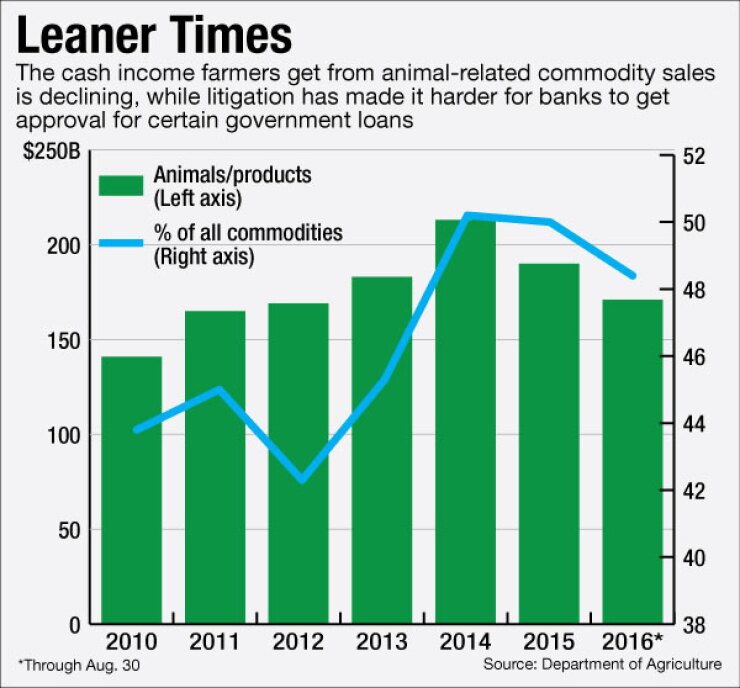
Banks are facing growing delays as they try to lend to facilities that house livestock.
Several lenders are complaining that it is taking longer to get approvals from the Farm Service Agency and the Small Business Administration. The banking industry claims that the agencies have stepped up scrutiny of applications after a lawsuit criticized how they handled an application tied to a hog-raising facility in Arkansas.
Such lags threaten to cut into loan production, while forcing some lenders to consider exiting that business, industry observers said.
"The banks are frustrated," said Steve Apodaca, senior vice president at the American Bankers Association's Center for Agricultural and Rural Banking. "The complaint that bankers have is the level of environmental due diligence is increasing … and it's just delaying the process."
The issue stems from a lawsuit that environmental groups filed in 2013 in the U.S. District Court for the Eastern District of Arkansas against the agencies, claiming that they failed to properly vet the potential environmental impact of a proposed hog farm before granting loan guarantees. A judge ruled in the groups' favor a year later.
The FSA subsequently updated its environmental-assessment policy for all loans, including those to livestock and dairy operations. The SBA also made changes.
Those changes have created "a massive amount of confusion" as everyone adjusts to the new requirements, said John Blanchfield, a principal at Agricultural Banking Advisory Services. Farmers in Iowa, Wisconsin, New York and Arkansas have felt the biggest impact from the changes, Apodaca said.
The SBA, which backs loans for facilities in rural areas involved in farm-related projects such as improving food-processing operations, did not provide a comment.
The FSA does not have a moratorium on loans to animal facilities, a spokesman said in a statement, adding that the agency is "currently meeting all credit requirements of its customers." The spokesman noted that the FSA provided a record $6.3 billion to nearly 40,000 farmers and ranchers in fiscal-year 2016.
Still, bankers said they are struggling to get responses about their customers' loan applications.
Bremer Bank, for instance, scrapped plans to combine an SBA 504 loan with a traditional mortgage for an expanding dairy operation after failing to get agency approval, said Michael DeLong, an agricultural business banker who works in Menomonie, Wis.
DeLong finally turned to the FSA to make the deal work, but the entire process took about a year. Timing for expansions is important in Wisconsin; construction during the winter is more expensive and it's preferable to move cattle in warmer months, DeLong said.
"I think there is just some uncertainty out there right now," DeLong said, adding that he is less likely to use the 504 program now. "It makes a difference if you don't know a time frame."
The size of the loan — and the project it backs — is important, industry observers said.
Animal facilities that reach a certain size are considered a concentrated animal feeding operation, or CAFO, which requires extra review about its environmental impact. Those operations are the ones facing most of the added scrutiny, Blanchfield said.
Government-backed loans tend to be much larger than typical bank loans, so losing a deal over an agency delay can severely cut into a lender's revenue. Delays also leave farmers stuck in limbo over whether they have the financing to proceed with a project.
"It is a concern from some bankers," said Mark Scanlan, senior vice president of agriculture and rural policy at the Independent Community Bankers of America. "It could certainly slow financing down and could prevent some projects from being financed."
Animal facilities face issues elsewhere, including debate over livestock living conditions. More bad press could spur some banks to pull back in order to reduce reputational risk, with Blanchfield drawing comparisons to banks' reluctance to lend to the marijuana industry.
Over time, it could be easier for banks to turn down business, Blanchfield said. "As a result, farmers who raise food will have a harder time accessing capital."





